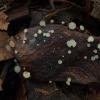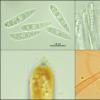
22-12-2025 23:38
Patrice TANCHAUDBonsoir, récolte sur un mur en pierre, apothéci

21-12-2025 09:32
Hello.A tiny ascomycete found embedded in wood in

22-12-2025 00:47
Patrice TANCHAUDBonsoir, récolte à proximité du milieu dunaire

21-12-2025 21:32
Pol DebaenstHello, Garden, Burgweg 19, Veurne, BelgiumOn 10/1

21-12-2025 21:40
Isabelle CharissouBonjour, j'aimerais connaitre les références de

21-12-2025 21:31
Pol DebaenstHello, Garden, Burgweg 19, Veurne, BelgiumOn 10/1

21-12-2025 21:31
Pol DebaenstHello, Garden, Burgweg 19, Veurne, BelgiumOn 10/1

20-12-2025 23:08
Patrice TANCHAUDBonsoir, récolte sur sol sablonneux dans l'arri�
Hymenoscyphus fructigenus on Acer?
Juuso Äikäs,
08-09-2020 21:52
Spores:
(18.8) 19.6 - 23.3 (23.9) × (3.9) 4.1 - 4.5 (4.6) µm
Q = (4.3) 4.5 - 5.2 (5.3) ; N = 10
Me = 21.3 × 4.3 µm ; Qe = 4.9
Hans-Otto Baral,
08-09-2020 21:55

Re : Hymenoscyphus fructigenus on Acer?
Yes of course it can. But nobody knows if it is genetically all the same. At least on Carpinus seeds occurs a different species.
Juuso Äikäs,
08-09-2020 21:59
Re : Hymenoscyphus fructigenus on Acer?
Ok then, good to know. It has a wider range of hosts than I previously thought.
Hans-Otto Baral,
09-09-2020 09:32

Re : Hymenoscyphus fructigenus on Acer?
I noticed I have a folder for Acer with some drawings. There are now also your pics.
The variation within Quercus is high, I have there a collection that is surely not conspecific with others on Quercus because of the broad spores with low lipid content.


